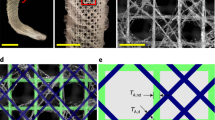Abstract
The physical, optical, and structural-chemica l properties of the spicules of glass sponges Hyalonema sieboldi, Pheronema raphanus, Pheronema sp. and their cross-correlation and changes during the modification of the phase state of the spicule material are investigated. It is experimentally shown that the spicules of a sponge are nanocomposite three-dimensional periodic structures which consist of the organic matrix and the amorphous silica; the most characteristic feature of the biomaterials is a different degree of silicon hydration over the cross-section of spicules. The material of spicules has the spectral-selective characteristics of the transmission in the region of 190–1500-nm wavelengths, which is determined by their three-dimensional periodic structure, organic matrix, and amorphous hydrated silica, as well as by the functional special features of spicules. The data obtained make it possible to consider the spicules of sea glass sponges as a promising prototype for biomimetic simulation to produce nanostructured optical materials for systems and devices of photonics.
Similar content being viewed by others
References
G. B. Khomutov, “Two-Dimensional Synthesis of Anisotropic Nanoparticles,” Colloids Surf., A 220, 243 (2002).
A. M. Alekseev, V. A. Bykov, A. F. Popkov, N. I. Polush-kin, and V. I. Korneev, “Observation of Remanent States of Small Magnetic Particles: Micromagnetic Simulation and Experiment,” Pis’ma Zh. Eksp. Teor. Fiz. 75(6), 318 (2002) [JETP Lett. 75 (6), 268 (2002)].
J. Aizenberg, V. C. Sundar, A. D. Yablon, J. C. Weaver, and Gang Chen, “Biological Glass Fibers: Correlation between Optical and Structural Properties,” Proc. Natl. Acad. Sci. USA 101, 3358–3363 (2004).
W. E. G. Müller, K. Wendt, Ch. Geppert, M. Wiens, A. Reiber, and H. C. Schröder, “Novel Photoreception System in Sponges?: Unique Transmission Properties of the Stalk Spicules from the Hexactinellid Hyalonema Sieboldi,” Biosens. Bioelectron. 21, 1149–1155 (2006).
Yu. N. Kul’chin, S. N. Bagaev, O. A. Bukin, S. S.Voznesenskii, A. L. Drozdov, Yu. A. Zinin, I. G. Nagornyi, E. V. Pestryakov, and V. I. Trunov, “Photonic Crystals Based on Natural Oceanic Biomin-erals,” Pis’ma Zh. Tekh. Fiz. 34(15), 1–7 (2008) [Tech. Phys. Lett. 34 (8), 633–635 (2008)].
M.-J. Uriz, X. Turon, M. A. Becerro, and G. Agell, “Siliceous Spicules and Skeleton Frameworks in Sponges: Origin, Diversity, Ultrastructural Patterns, and Biological Functions,” Microsc. Res. Tech. 62, 279–299 (2003).
J. Aizenberg, J. C. Weaver, M. S. Thanawala, V C. Sundar, D. E. Morse, and P. Fratzl, “Skeleton of Euplectella sp.: Structural Hierarchy from the Nanos-cale to the Macroscale,” Science (Washington) 309, 275–278 (2005).
W. E. G. Müller, Xiaohong Wang, K. Kropf, H. Ush-ijima, W. Geurtsen, C. Eckert, M. N. Tahir, W. Tremel, A. Boreiko, U. Schlösmacher, J. Li, and H. C. Schröder, “Bioorganic/Inorganic Hybrid Composition of Sponge Spicules: Matrix of the Giant Spicules and the Comita-lia of the Deep Sea Hexactinellid Monorhaphis,” J. Struct. Biol. 161, 188–203 (2008).
Yu. N. Kul’chin, O. A. Bukin, S. S. Voznesenskii, A. N. Galkina, S. V. Gnedenkov, A. L. Drozdov, V. G. Kuryavyi, T. L. Mal’tseva, I. G. Nagornyi, S. L. Sinebryukhov, and A. I. Cherednichenko, “Optical Fibres Based on Natural Biological Minerals—Sea Sponge Spicules,” Kvantovaya Elektron. (Moscow) 38(1), 51–55 (2008) [Quantum Electron. 38 (1), 51–55 (2008)].
Xiaohong Wang, Jin-He Li, Qiao Li, and H. C. Schre-der, “Structure and Characteristics of Giant Spicule of Deep Sea Hexactinellid Sponges of the Genus Monorhaphis,” Acta Zoologica Sinica (Dongwu Xue-bao) 53(3), 557–569 (2007).
J. C. Weaver, L. I. Pietrasanta, N. Hedin, B. F. Ach-melka, P. K. Hansma, and D. E. Morse, “Nanostruc-tural Features of Demosponge Biosilica,” J. Struct. Biol. 144, 271–281 (2003).
H. Ehrlich, A. V. Ereskovskii, A. L. Drozdov, D. D. Krylova, T. Hanke, H. Meissner, S. Heinemann, and H. Worch, “A Modern Approach to Demineraliza-tion of Spicules in Glass Sponges (Porifera: Hexacti-nellida) for the Purpose of Extraction and Examination of the Protein Matrix,” Biol. Morya (Vladivostok) 32(3), 217–224 (2006) [Russ. J. Mar. Biol. 32 (3), 186–193 (2006)].
H. Ehrlich, S. Heinemann, Ch. Heinemann, P. Simon, V. V. Bazhenov, N. P. Shapkin, R. Born, K. R. Tabachnick, Th. Hanke, and H. Worch, “Nanostructural Organization of Naturally Occurring Composites— Part 1: Silica-Collagen-Based Biocomposites,” J. Nanomater. 2008, Article ID 623 838 (8 pages) (2008).
H. Ehrlich, M. Krautter, Th. Hanke, P. Simon, Ch. Knieb, S. Heinemann, and H. Worch, “First Evidence of the Presence of Chitin in Skeletons of Marine Sponges: Part II. Glass Sponges (Hexactinellida: Porifera),” J. Exp. Zool., Part B 308, 473–483 (2007).
P. Fratzl, “Biomimetic Materials Research: What Can We Really Learn from Nature’s Structural Materials?” J. R. Soc. Interface 4, 637–642 (2007).
H.-C. Schröder, S. Perović-Ottstadt, M. Rothenberger, M. Wiens, H. Schwertner, R. Batel, M. Korzhev, I. M. Müller, and W. E. G. Müller, “Silica Transport in the Demosponge Suberites Domuncula: Fluorescence Emission Analysis Using the PDMPO Probe and Cloning of the Potential Transporter,” Biochem. J. 381, 665–673 (2004).
W. E. G. Müller, C. Eckert, K. Kropf, Xiaohong Wang, U. Schloßmacher, Ch. Seckert, S. E. Wolf, W. Tremel, and H. C. Schröder, “Formation of Giant Spicules in the Deep-Sea Hexactinellid Monorhaphis Chuni (Schulze 1904): Electron-Microscopic and Biochemical Studies,” Cell Tissue Res. 329, 363–378 (2007).
Author information
Authors and Affiliations
Corresponding author
Additional information
Original Russian Text © S.S. Voznesenskii, A.N. Galkina, Yu.N. Kul’chin, A.A. Sergeev, 2010, published in Rossiiskie nanotekhnologii, 2010, Vol.5, Nos. 1–2.
Rights and permissions
About this article
Cite this article
Voznesenskii, S.S., Galkina, A.N., Kul’chin, Y.N. et al. Nanostructured marine biominerals as a promising prototype for the biomimetic simulation. Nanotechnol Russia 5, 142–152 (2010). https://doi.org/10.1134/S1995078010010155
Received:
Published:
Issue Date:
DOI: https://doi.org/10.1134/S1995078010010155




